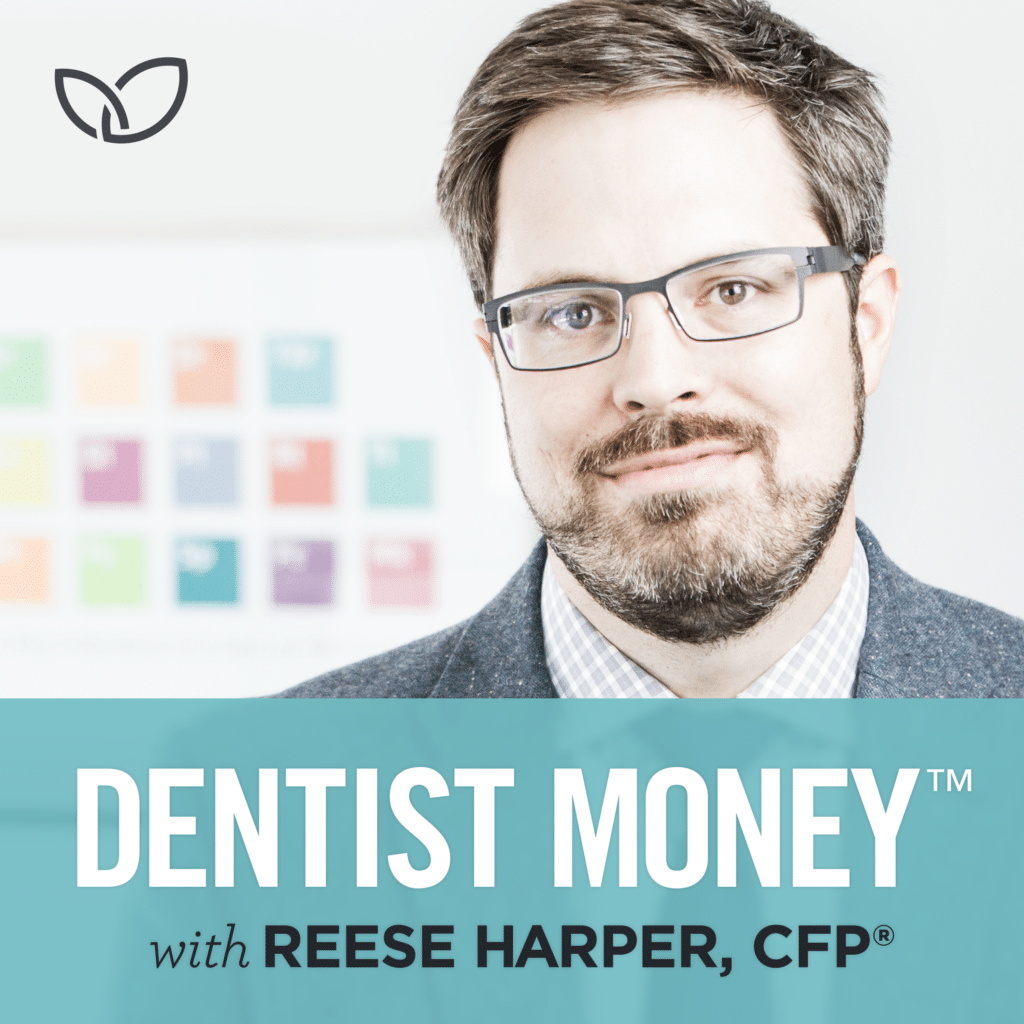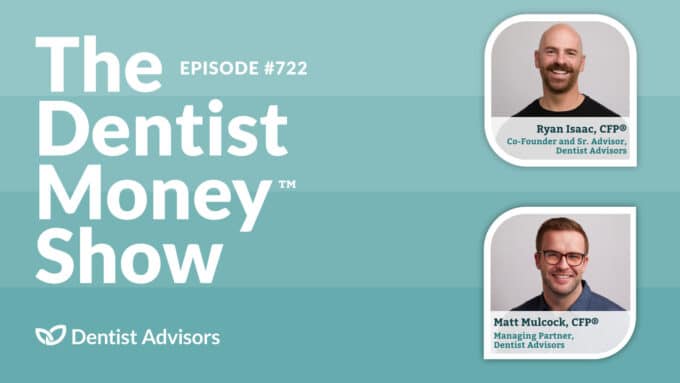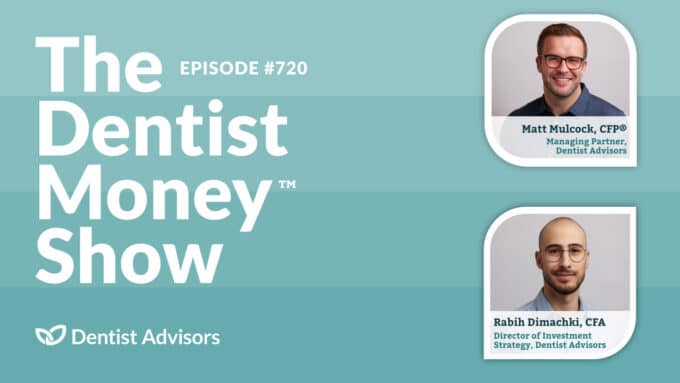How Do I Get a Podcast?
A Podcast is a like a radio/TV show but can be accessed via the internet any time you want. There are two ways to can get the Dentist Money Show.
- Watch/listen to it on our website via a web browser (Safari or Chrome) on your mobile device by visiting our podcast page.
-
Download it automatically to your phone or tablet each week using one of the following apps.
- For iPhones or iPads, use the Apple Podcasts app. You can get this app via the App Store (it comes pre-installed on newer devices). Once installed just search for "Dentist Money" and then click the "subscribe" button.
- For Android phones and tablets, we suggest using the Stitcher app. You can get this app by visiting the Google Play Store. Once installed, search for "Dentist Money" and then click the plus icon (+) to add it to your favorites list.
If you need any help, feel free to contact us for support.
Subscribe to the Dentist Money™ Show for free
As a dentist, you might have a general sense of your financial situation based on your collections, income, and retirement accounts. But have you ever wondered how your performance compares to other dentists? This episode of Dentist Money Show™ explains why it’s important to benchmark your performance against your peers, and how to make simple calculations to monitor your financial progress.
Watch this video to see the inspiration behind episode 14.
Podcast Transcript:
Reese Harper: Welcome to the Dentist Money Show, where we help dentists make smart financial decisions. I’m your host, Reese Harper here with my co-host Sir Ryan Isaac Esquire III.
Ryan Isaac: Good day, Mr. Harper.
Reese Harper: I didn’t know if you knew that you had that title.
Ryan Isaac: Yeah, it’s not on my business card or my email signature. It’s too long.
Reese Harper: Well good day to you too, son. I want you to share a story with me today that is about everyone’s favorite exercise activity: running.
Ryan Isaac: Yeah! We’re going to talk some running today. I think we probably have some runners listening out there I’m sure. You’ve probably heard of the story. There’s this race in Australia—it’s an ultra marathon called the Sydney to Melbourne. It’s 544 miles long. It takes 5-6 days to finish. There’s this story where this race happened in 1983, there’s this sixty-one-year-old local potato farmer. I didn’t know, by the way, that Australia was big on potatoes.
Reese Harper: Shout out to you potato farmers out in Idaho.
Ryan Isaac: So, sixty-one-year-old potato farmer. His name is Cliff Young. He shows up to compete against these other racers that are world-class athletes. They are there in their running gear—they’ve got sponsors logos. And he literally shows up wearing overalls and galoshes.
Reese Harper: For those of you who don’t know what galoshes are, they are rubber boots.
Ryan Isaac: Rubber boots. Not meant for running.
Reese Harper: Did he really have those? Why would you run in rubber boots? That’s the worst thing to run in, but he did it.
Ryan Isaac: Cliff didn’t know. The race starts—all the runners get way ahead of him of course. He’s in galoshes, and he’s sixty-one year old Cliff. He’s not running either; he’s doing this shuffle. His feet are just shuffling back and forth constant and steady. So normally the strategy for the runners is they run about eighteen hours as best as they can, and then they sleep for 4-6 hours. Cliff didn’t really feel like he needed to sleep though. So while everyone else slept, he just kept shuffling down the road. The reason why he is doing this—he actually grew up on a farm where his family wasn’t able to afford any horses or four-wheelers. They ran sheep, and they couldn’t afford those things. So whenever the storm rolled in they would have to get 2,000 head of sheep all rounded up on foot, and so sometimes he would have to run those sheep two or three days straight without sleeping. And so as he was running the race, he would keep in mind that a storm is rolling in, and he would motivate himself by thinking he’s got this head of sheep. So anyway, over the course of five days he only allows himself about twelve hours of sleep. And be basically only stopped for food and bathroom. So as a result, what happened is he won the race; he set a new course record; and he beat the second place finisher by about ten hours.
Reese Harper: No way. Cliff Young for the win. That’s a pretty cool story. So you’re saying that the advice today on the podcast is to work and never sleep. Keep working and never sleep. That’s the only way to get ahead.
Ryan Isaac: Yeah that’s it. That’s perfect, we’ll end it there. Thanks for listening everybody. This has been the Dentist Money Show where we help dentists make smart financial decisions.
Reese Harper: Okay, backing up. Maybe there’s another lesson you had in mind. Let’s go ahead and set the premise here for the real lesson.
Ryan Isaac: Funny you mention that. There’s actually a point to my story. There’s probably several morals to this story: it could be maybe that there is a lot of ways to get something accomplished. It could be that you shouldn’t judge someone by their appearance. But what we will talk about today is the story of benchmarking.
Reese Harper: So this is a story about benchmarking.
Ryan Isaac: Yeah, it’s about measuring performance, and how when you know something is possible it becomes more attainable, and so when Cliff blew through this course record and he beat everyone like he did—what do you think happened after that?
Reese Harper: Probably everyone that’s racing realized they had to run that race without sleeping.
Ryan Isaac: And a lot of them started doing the Cliff Young shuffle to conserve energy. All of the sudden they had this new standard to meet which was proven to be attainable by ol’ Cliff, and the result was that they took a new approach to the race and they got faster the next year. So without Cliff, they would have just kept doing the same thing—run for eighteen hours and then sleeping for four or six.
Reese Harper: This is something I’m kind of passionate about. The average retirement age of a dentist is age sixty-seven right now according to the ADA Study. Of 12,000 people surveyed, the average retirement of dentists was sixty-seven; the average U.S. retiring at sixty-two, and that same disparity has been there for decades. The same thing is going to keep happening and happening until someone proves otherwise, right? It’s like the four-minute mile. Do you remember that? Roger Bannister. That guy was a legend. I remember also there was a Fosbury Flop. Do you know what that is? The Fosbury Flop is a high jump technique. When I was young, I did it the old school way. We were diving over the high jump face first. That’s really way I’ve never been able to jump over a high jump bar.
Ryan Isaac: Oh you’re talking about the Olympic high jump in track?
Reese Harper: The most important event of the Olympic games. They are running—they used to jump over and it rubbed their stomach going over. Now they run and they flip over backwards. They kind of do a little convulsion and kick up their feet at the end. Fosbury Flop—no one was doing that before until Fos did it, and now they are jumping almost a foot higher than they used to.
Ryan Isaac: So the principle is when you see somebody doing something else, it’s a wake up call. So let’s use this concept and we’ll talk about how benchmarking can be used to attain your financial goals and outperform your current trajectory. So we use the same principle to help dentists that we work with. We are able to take all the financial data we get from our clients, and we use it to establish a low, mid, and high range for various metrics we are measuring. When one of our dentists gets a financial report, he can see how his performance compares to a few things, like his peers.
Reese Harper: And the underlying principle is the performance is going to improve just by being compared to other people. As you saw with Cliff Young for the win, the Fos Flop, and one thing I’ve noticed is that in some ways it introduces an element of competition that motivates each client to perform better. It’s not like we’re sending out a monthly report that says, Dr. So-and-So is ranked number one, and he’s earning this much—it’s a transparent measurement that people can look at and see that their performance may not be measuring up to the numbers being produced by other people. It gives people a wake up call like you mentioned.
Ryan Isaac: Great. Let’s get a little technical now and talk about making the numbers in your life actually useful.
Reese Harper: I talk about a lot of this during my presentation at dental events. There’s all these different numbers that can be used to describe a dentist’s finances—you have your collections, your overhead, your profitability, your tax rate, loan balances, practice loans, person income, retirement plan balances, mortgage. There’s a ton of numbers you can look at, but numbers by themselves don’t mean anything. If I told you a dentist’s collections were at $750,000, is that good or bad? Should he be happy about that?
Ryan Isaac: It depends.
Reese Harper: Oh what?
Ryan Isaac: A lot of things. What were his expenses? How does it compare with collections from the previous year? How do collections compare to other dentists in similar situations?
Reese Harper: So in order to make that $750,000 in collections useful, you have got to bring in another number. And there’s a few ways to do this.
Ryan Isaac: Yeah, right. So one way is that you can compare a number to itself just over time.
Reese Harper: Yeah, so you take your collections and see how it looks from different time periods. So for example, if you collected $750,000 in 2015 and then you take $900,000 in 2016 you can compare your collections from different years, and you can see that you improve by $150,000 or 20%. It doesn’t tell the whole story, but at least it gives you some sense for how you’re trending, right?
Ryan Isaac: Yeah, it’s kind of how when a runner times himself to gauge his own personal improvement over time. So if you don’t have the stop watch though you get to the end of the mile at any given day and think—that felt pretty good. That was a good run.
Reese Harper: Yes, or the front jump on the high jump, the Fosbury Flop. It used to rub, doesn’t rub—so when he times himself he’s got some kind of objective measurement to use. Anything you measure it’s subjective—it gets you oriented and lets you know where you stand.
Ryan Isaac: Yeah, so then the next way you can do it is you can compare in number to a different kind of number.
Reese Harper: Yeah, and this is much more useful than the first way. You take one number like your income, and you divide it by another number like collections. In this case you will end up with profitability or your profitability ratio.
Ryan Isaac: Income divided by collections and profitability.
Reese Harper: Yeah, and that’s a more important number than your income alone because it tells you to a greater extent how well you’re managing your business. And then there’s one other way it’s important.
Ryan Isaac: Yeah, and the third way you can do it is compare your numbers to somebody else’s numbers.
Reese Harper: And more specifically compare your ratios to someone else’s ratios. What I mean by that is rather than saying, “I collected a million and a half, and he collected a million—I must be doing pretty good.” You want to use ratios like your profit to make the comparison. So you take your numbers, you turn them into ratios and you that puts everything on an even playing field, right?
Ryan Isaac: Right. Maybe you did a 1.5 and your buddy did a million, but by the time you took out your expenses, maybe you both took home the same $250,000. And if we use those numbers—you had a profit margin of 17% and he had a profit margin of 25%, but he had more collections, and now you have this level playing field that you’re talking about.
Reese Harper: Yeah, and both of you in that example you gave would not be making that much profit. So if we compared that to your peers we would be like—you’re both doing bad, but one is doing worse. That’s the number you want to compare though is that margin. So that’s where you want to start.
Ryan Isaac: So then the next question would be—how can our dentists that are listening implement this philosophy. Should they start calling their buddies and asking what their profit margins look like?
Reese Harper: Well yeah, if you feel close enough to them. Lots of your friends are talking about this kind of stuff anyway, but it’s probably easier to talk to your CPA or a financial advisor who works with other dentists and say: how does this number compare to another number of a typical dentist? Or how does this ratio compare to the ratio of another dentist? But let’s talk about some actual ratios that aren’t just profit margin. That’s the easiest one to think of and everyone’s familiar with that, but the ones we look at are much more related to someone’s wealth. And that’s where we have kind of innovated, and we feel like we have some ratios that are important.
Ryan Isaac: Yeah, so we love our listeners. We want to give them some good examples here, so let’s give them an example of a ratio that we use to track some performance. If you’re listening you can make your own calculations, and then you can compare them to these ratios when you get a chance.
Reese Harper: Let’s start with a super simple one—we call it your Liquid Term. Every January we bench mark this statistic for our clients. It basically measures the number of years that you could live on everything that’s liquid. Your bank accounts, personal and practice, and any investments that you have that are not inside a retirement plan—so stuff you can get at really quickly. It’s usually always going to be an investment of some kind that’s not in a retirement plan or your cash or a liquid security.
Ryan Isaac: Let me ask you a question we get when we talk about liquidity and retirement plan. When you say retirement plan, most people think of only IRAs and 401Ks and simple IRAs. You can have a retirement plan that’s outside of that—that’s what you’re saying?
Reese Harper: Yeah totally. A lot of people’s money for retirement isn’t inside of a 401K or an IRA. They’re investing it in an account that’s growing, but it’s not in a 401K or IRA. That’s what we’re looking at when we say Liquid Term. Because stuff that’s in your 401K is not liquid because you’re penalized if you take it out, so from our perspective it’s not easily accessed without a penalty. So you add up your cash and all your investments that are not in your 401K or IRA, and you divide that by your spending. You divide that by what you spend in one calendar year. So add up all your numbers, and divide it by your annual spending. If you’re forty years old and your liquid term is only a one—let’s say your total dollar amount is $250,000 but you spend $250,000, then you’re at a one. You could live for one year on your liquidity investments. Now if you’re a one and you’re forty, that’s really not liquid enough. You haven’t developed good habits to restrain yourself from purchasing or investing or growing your practice obsessively. You’ve just got to build some liquidity and have more balance. If you’re above a ten and you’re forty, you’re doing pretty awesome. That was our high statistic for this group. But if you’re at a three or a four, you’re probably doing just fine coming in right around the average. So just like Liquid Term—there’s twelve ratios we track and Liquid Term is one of the twelve, and we call these Elements. At the end of the day, they are meant to help you improve your primary ratio—the mother of all ratios, which we call your Total Term. The Total Term—this is the number that tells you how close you are to retirement.
Ryan Isaac: And you can calculate this Total Term by a few steps. First, you need to take all of your assets— your cash, your investments, your real estate, the value of your practice. Then subtract your total debts—your student loans, your practice loans, your personal debts. That gives you something called a net worth. That’s what you are worth—money—not intrinsically as a person.
Reese Harper: You’re a good person even if it’s negative.
Ryan Isaac: It’s your net worth. You take that net worth, and you divide that by your annual spending. That gives you your Total Term number, and what this ratio does is it tells you approximately how many years you could live on your current assets if they didn’t grow; if you just retired right now. So for example, if your net worth is a million dollars and you spend a hundred thousand annually—that’s personal spending at home—then your current wealth can support you for about ten years.
Reese Harper: Let’s give them a range for some context. You want your Total Term to be around a thirty when you’re ready to retire. Now I would say if you have a lot of equity in your primary residence—meaning if you hit a thirty and a big chunk of it is in your house. And you’ll know that because another one of the elements is called an RT, which is your Real Estate term. Your Total Term will support you through your retirement—it’s a good gauge. If you’re at a twenty you’re probably barely getting ready for retirement. Thirty is secure, and forty would be like you’re crushing it; you’re doing awesome. So you want to make sure that your Total Term really is close to a thirty, at least a twenty before you start thinking about retirement.
Ryan Isaac: And we’ve got a really comprehensive guide. We just published an e-guide—it’s called The Only Number You Need to Calculate Your Retirement. This e-guide that we just published, it will explain this concept of Total Term in a lot more detail and give you some benchmarks and some ranges on where you might want to be.
Reese Harper: It will show you how to calculate it, and you won’t have to remember all this. Just go to dentistadvisors.com/signup for that Total Term e-guide.
Ryan Isaac: Yes, and we will give it to you right away. Closing thoughts, Reese?
Reese Harper: Here’s what I want to conclude—you need to compare your performance to reality, not your perception. Don’t just look at your dental school buddy’s practice and say—man he’s in a prime location; he’s got an amazing building; he’s got flat screens all over his office, and a giant fish tank with cool tropical fish. He’s got state of the art equipment, a bunch of associates; he’s killing it. That’s all perception. Now don’t reach conclusions about someone else’s financial health based on what you feel or what you think is happening. You’ve got to base it on what’s real, and that’s why we benchmark. It’s the right kind of motivation. It motivates you to actually pursue things that stretch things a little bit but don’t make you feel guilty about not being in the right place or not growing fast enough. I really think it’s important to benchmark in order to get the right motivation.
Ryan Isaac: And it’s based on data driven factual context, not the thing your friend says that’s happening that makes you feel insecure or that you’re not doing things as well. Give me an example then what you’re talking about. Have you ever seen a benchmark like this work that motivated someone in their life?
Reese Harper: Totally. Back in 2009, I remember showing a client that he should be saving about 25% of his gross income based on where he was at with collections. That was his benchmark metric; it was the median for where he was really at. I remember him looking at me like, are you crazy? I can’t save that much money. But the thing that was crazy was that once I started showing him some benchmark comparisons and we started putting numbers in front of him so he saw what was real, he started accumulating more and more. And this year his Savings Rate was over 30%, and when we met he was saving just less than 10%. So I’ve seen that person go from 10% to over 30%, and it’s all because of having real measurable, calculable data that he knew was real. It wasn’t just a national average; it wasn’t a rumor. Benchmarking matters, and it works; especially if you’re comparing to the right data points.
Ryan Isaac: So he pretty much saw the financial version of Cliff do the shuffle, and it worked. It changed his behavior. Use the numbers: that’s the moral of the story. They hold you accountable; they push you to improve, and most importantly, the numbers don’t lie. The reason lesson from today is if you’re sixty-one and you’re thinking of running a marathon—do it. Throw on your boots and get out there and shock the world with your farmer shuffle. That’s the other lesson to take away from today. And you know what else is cool about this Cliff Young guy? This is probably the best part of the story—he didn’t know there was a prize for winning the race. There was a $10,000 prize, and so when they gave it to him, he decided that the other racers needed it more than he did, so he just split the winnings among the next five finishers.
Reese Harper: That’s really cool, although it probably didn’t improve his ratios that much did it?
Ryan Isaac: He’s a stud. Well, thanks for listening. Remember, leave us a review on this podcast, and if you would like more information go to dentistadvisors.com and you can sign up for our free newsletters. You can schedule an appointment on our calendar. We also have our phone number on there—give us a call anytime; we’d be happy to chat.
Reese Harper: Carry on.
Tracking Progress




